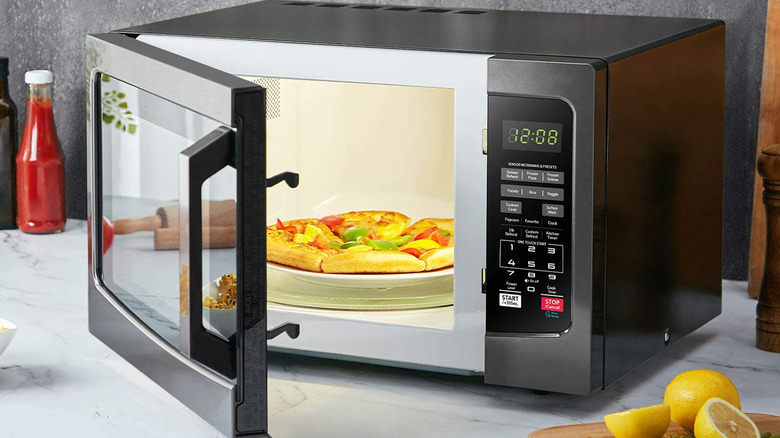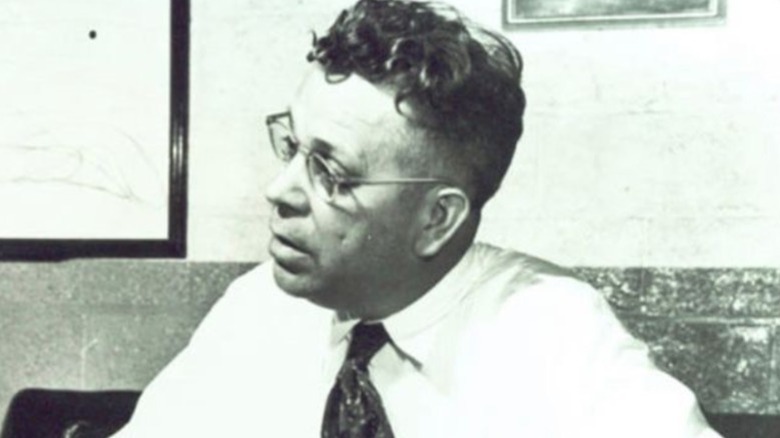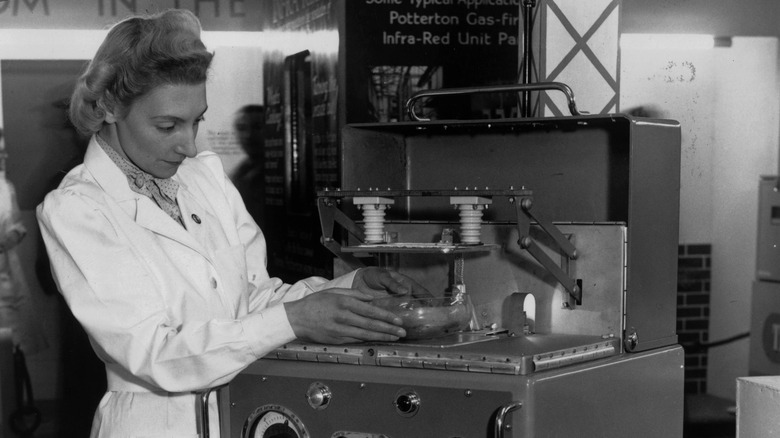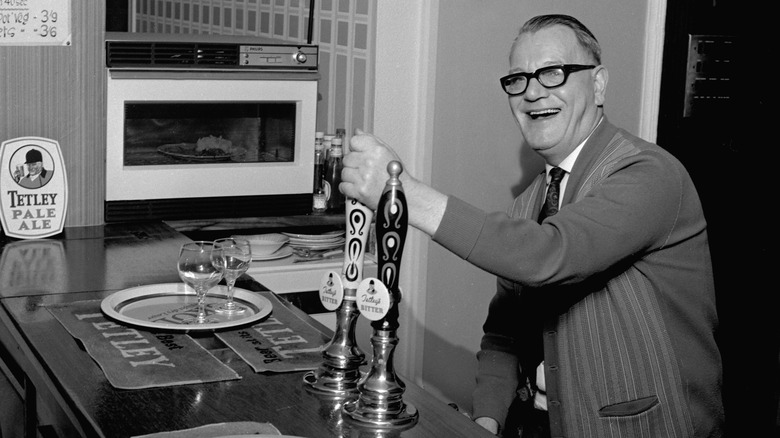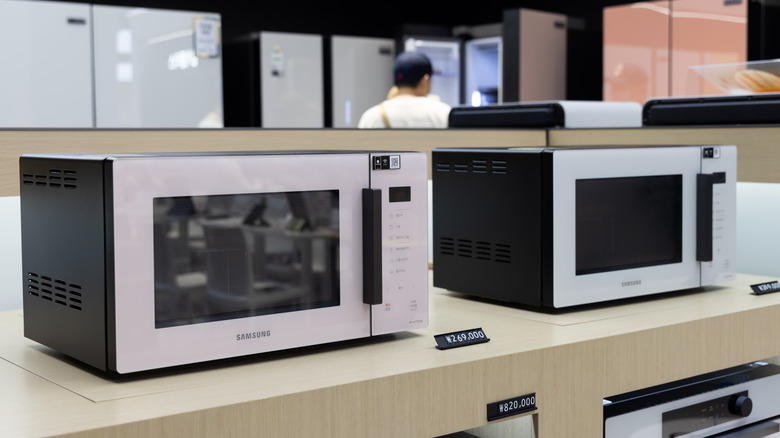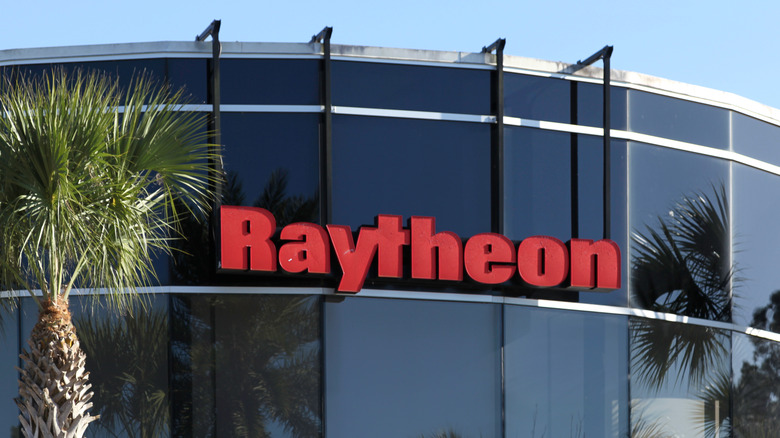Who Really Invented The Microwave?
Microwave ovens are a staple appliance in most modern American homes; according to the Bureau of Labor Statistics, by October of 2001, 90% of all homes in the United States contained one. Their ubiquity is a far cry from the highly specialized, enormous, expensive microwaves of its early days. Like many inventions, the microwave oven's technologies were discovered by accident in 1945 while its inventor was working on something else.
As reported by Business Insider, engineer Percy Spencer was working in a lab at Raytheon Technologies, an aerospace and defense corporation in Waltham, Massachusetts. Spencer was testing the vacuum tubes found within radars that produce microwaves, known as magnetrons, when he noticed that a peanut cluster bar in his pocket had melted due to its proximity to the magnetron's microwaves. According to his grandson Rod Spencer, the elder Spencer "put two and two together and he decided to get some popcorn, so he sent the popcorn in and it started popping all over the place." A test with an egg followed, which led to the egg exploding, confirming that microwaves could heat food very quickly.
The self-taught inventor from Maine
Percy Spencer was born in 1894 in Howland, Maine, as reported by Popular Mechanics. He had very little formal schooling and started working at a spool mill when he was just 12 and was installing electricity in a paper mill by the time he was 14. Spencer became interested in radio technology after hearing about the heroic radio operators working on the Titanic. He joined the Navy to learn more, later explaining, "I just got hold of a lot of textbooks and taught myself while I was standing watch at night."
After his stint in the Navy during World War I, Spencer got a job at the American Appliance Company, which changed its name to Raytheon Manufacturing Company in 1925. While at Raytheon, Spencer developed a reputation for being an excellent problem solver and worked on improving radar technology. During World War II, he helped develop detonators that allowed users to trigger artillery shells to explode in mid-air.
The 750-pound microwave oven
Raytheon engineer and historian Chet Michalak told Popular Mechanics that Spencer "had a knack for finding simple solutions to manufacturing problems." Rod Spencer put it another way: "There were no 'challenges,' simply everything was a goddamn problem that needed to be solved. Everyone trusted him to do just that." Raytheon filed patent number US2495429A, "Method of treating foodstuffs," on October 8, 1945, with the classification "general methods of cooking foods, e.g. by roasting or frying using wave energy, irradiation, electrical means or magnetic fields, e.g. oven cooking or roasting using radiant dry heat."
Two years later, as reported by Wired, it built the world's first microwave and named it the Radarange. It was the size of a refrigerator but heavier, weighing in at 750 pounds, and it required plumbing, as its tubes needed to be water-cooled. In 1954, Raytheon introduced the first commercial microwave oven, the 1161 Radarange, after testing it in a Boston restaurant's kitchen.
The first home model
The first Radarange was still too expensive even for most professionals — it was priced at $2,000 to $3,000, which is the equivalent of $21,000 to $31,000 in today's money, according to the U.S. Inflation Calculator. Per the National Museum of American History, a restaurant in Cleveland, Ohio purchased the first one. Raytheon licensed its microwave technology to the Tappan Stove company, and Tappan developed and introduced their 220-volt wall unit, the RL-1 as a home microwave oven in 1955, as reported by the National Museum of American History, which keeps an RL-1 in its permanent collection.
It retailed at $1,295, or about $13,700 today, making it well beyond affordable for most United States households. People were confused about how and when to use the appliance at home. Per Wired, it had two cooking speeds (500 and 800 watts), a top-browning element, a steel exterior with an internal glass shelf, and even its own recipe card drawer. Tappan manufactured just 34 RL-1 microwaves in 1955, and by the time production ended in 1964, they'd sold only 1,396 units.
Breakthrough in the 1970s
In the 1960s, Litton Industries bought a small subsidiary called Franklin Manufacturing from Studebaker, known primarily as a car manufacturer. Franklin Manufacturing had been making and selling microwave ovens similar to the Radarange, and Litton tinkered with the ovens' size, design, and capacity, building the first short, wide microwaves that we're familiar with today and selling them at a much more reasonable price point than their larger predecessors.
As reported by Wired, Raytheon acquired a company, Amana, with which they introduced the first popular home model microwave oven, the counter top Radarange, in 1967. It retailed for $495, or about $4,200 in 2022 dollars. Consumer interest in microwave cooking grew and people's distrust surrounding the technology faded. By 1970, 40,000 microwaves had been sold in the United States, and by 1975, the total number was 1 million. Within another decade, 25% of American households had a microwave. Per Illumin Magazine, by the mid-1970s microwave ovens were more popular than gas ranges and dishwashers.
What's next for microwave ovens?
Microwave technology didn't change much from the 1967 Radarange countertop model until 2018 when Austin, Texas company Freescale introduced a new concept in microwave technology that heats faster and in a more targeted manner, even taking into account different types of food on the plate. Per Food & Wine, this is accomplished by using radio frequency emitters, similar to the ones used to power cell phone towers, as opposed to the "cavity magnetrons" discovered by Percy Spencer at Raytheon back in the 1940s.
Percy Spencer was inducted into the National Inventors Hall of Fame in 1999. He held over 150 patents in the course of his career and eventually became a senior vice president at Raytheon as well as a member of their board of directors. He continued working there until his death in 1970; a building on the corporation's campus was named in his honor. According to the American Physical Society, Spencer's sole monetary reward from his invention was the $2 Raytheon gave as a bonus to employees whose inventions were patented. Spencer received an honorary doctorate from the University of Massachusetts and, according to engineer and Raytheon founder Vannevar Bush, he "earned the respect of every physicist in the country, not only for his ingenuity, but for what he has learned about physics by absorbing it through his skin."
